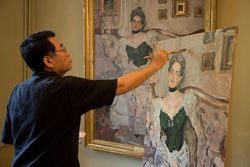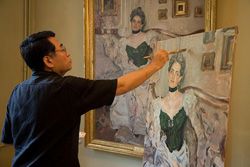Peculiarities of artistic literature translating


The translation of artistic text as any type of translation has its own peculiarities and is considered to be the most labour-intensive. Many translators qualify artistic translation as the most studied and easy. These translations are distinguished by their novelty, specialty and striving to modernize. One of the peculiarities of artistic text is a great number of figures of speech and different expressive means in the source language, which should be rendered with all its stylistic peculiarities, sense and other nuances. This practice comes from ancient times, as the majority of the nowadays expressive means appeared in Antiquity. Moreover, the translator of artistic text should be bright and keen-witted, as in artistic literature one usually comes across a play of words, which should be rendered with proper sense, conveying the author’s idea.
Artistic translation shouldn’t be carried out word-for-word, in this case the special thrill in describing the characters and the peculiarities of their speech, the colouring of the scenery and the special flavour of the time period will be lost. Nevertheless, it’s not possible to render all the expressive means of the original. As the majority of translators admit, many jargon, folklore and dialect figures of speech remain untranslatable.
However, the situation can be saved by the following means:
- Dialecticisms are used to translate abusive language, jargon, colloquial language, maintaining stylistic colouring.
- Comparison is used to render phrases, taking into account stylistic and structural peculiarities.
- Irony enables the interpreter to compare the incomparable and to express the peculiarities of the speech in contrast.
- Metaphors are necessary to render structural characteristics.
- Using play of words one can render the ambiguity of the source language.
- The syntactical specificity of the original is a play of contrast: long and short sentences, well-defined rhythm etc.
The translations have detected the most wide-spread problems, which occur most often.
- Artistic texts shouldn’t be translated “by tracing”, or word-by-word. Moreover there cannot be two absolutely identical translations. Somebody will try to preserve the author’s style, the other will emphasize the syntactical structure. Thus, the translator should have style of his own, should be a writer and even imaginative.
- The translation of phraseological units can turn out to be a problem, if the interpreter doesn’t have different special dictionaries and his own vocabulary leaves much to be desired.
- The translation of humour. The things, funny in English, can be not funny at all in Russian translation, and sometimes even foolish.
- The preservation of the breath of the epoch and culture. Here one can’t manage without constant broadening of his or her outlook, as the text may apply to a certain time period, which should be rendered in translation.
The main aim of the interpreter of an artistic text will always be the maintenance of individuality and the adaptation of the material for a certain culture.


 Cash payment
Cash payment  Yandex.Money: 410012433351166
Yandex.Money: 410012433351166 Qiwi: 9080789885
Qiwi: 9080789885 Non-cash payment: INN 7451284037
Non-cash payment: INN 7451284037 Webdesign by —
Webdesign by —